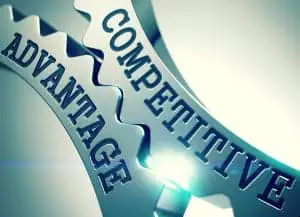In this article, we will know more about SpaceX Competitive Advantage.
Revolutionizing space travel, SpaceX has gained a competitive edge in the industry because of its cost-leadership strategy. It leverages its in-house manufacturing facilities and R&D capabilities to reuse the rocket components and make the offerings incredibly cheaper than its competitors. Future projects are focused on developing a fully reusable spacecraft resulting in significant cost savings.

Due to unexplained delays in the projects of NASA, the Commercial Space Launch Amendments Act was given legal status in 2004, opening up doors for private entities. Established in 2002, SpaceX is one of the pioneers in the space rocket manufacturing and transportation industry who has a mission to make travel to space convenient and more affordable. The company’s product and service offerings are listed below:
- Several launch vehicles
- Myriad of rocket engines
- Dragon capsules
- Starlink ASDS landing platforms
- Orbital rocket launch
- Satellite internet
SpaceX has managed to retain the top position on the space industry’s leader board because of the following aspects:
- Product Differentiation: First-stage engine, second-stage engine, and rocket boosters are the components of a rocket that increases its production cost. SpaceX has developed a transformative technology of manufacturing reusable rocket components that significantly reduces cost. The prototype of super heavy Starship spacecraft has successfully cleared the testing stage. This super-heavy rocket can carry cargo and crew to space marking another milestone for SpaceX.
- Manufacturing Unit & Team Differentiation: The different workstations of the company connect with the help of NX (software developed in-house) with each other, which facilitates seamless communication amongst the team members working in different buildings. The ability to assemble such a big machine with a large number of assemblies on time is transforming the dynamics of the space industry.
- Cost leadership: The future projects of SpaceX are working on to produce low-cost rockets that will penetrate the space manufacturing market to its core. It has triggered the interest of large investors in the next-generation launch systems. Along with the significant cost-saving opportunity due to reusability, SpaceX has the alternative to outsource the reusable components to another rocket launching firm. This strategy of commercializing its supply chain can help SpaceX to engulf the funding gap.
Porter’s Five Forces Framework Discussion
- The threat of New Entrants: The industry is hyper-competitive and is witnessing a proliferation of start-ups. Astra, a strat-up established in 2016, aims to offer smaller and frequent launches as a service at an affordable cost. But the barriers to entry in this industry are significantly high as it is an expensive industry and needs massive capital investment. On the contrary, SpaceX has prominent brand loyalty.
- Bargaining power of suppliers: This force of market analysis is not a trouble for SpaceX as they manufacture 70 percent of its products in-house.
- Bargaining power of customers: The bargaining power of customers depends upon the differentiation you create for your business. SpaceX has multiple differentiating factors, and the most reliable and unique one is its capability of producing reusable components. It is a mix of product differentiation that further leads to cost differentiation, and therefore, SpaceX does not face a challenge of the bargaining power from customers.
- The Threat of Substitute Products: The severity of this threat is lesser because of the expensive nature of the industry. The players use advanced technology that requires a robust R&D facility, and one must have a well-organized competitive team to innovate.
- Industry Rivalry: There are too many large-scale competitors available in the market. SpaceX competes with five major players, and Blue Origin is the closest. The level of differentiation between the two players is low, and therefore, the price competition is intense, and barriers to exit are high.
Has SpaceX conducted any successful flights to space with humans onboard?
SpaceX became the first private organization to successfully launch and return the astronauts of NASA to and from the ISS in May 2020. Its Dragon spacecraft can carry seven passengers and cargo to space and land them safely back on earth.
The Starship SN15 will be the first spacecraft with a fully reusable space travel system and carry the crew and cargo to and from space. The team has completed the test flight and landing successfully.
Does SpaceX have a competitive advantage over Blue origin?
It has a clear advantage over Blue Origin because of its product quality, secure designs, and cost differentiation. It is more evident from the recent incident of Blue Origin losing a $2.9 billion contract of building the Human Lander System for the astronauts of NASA to SpaceX.
Conclusion
The Differentiation strategy of a company differentiates its products, services, and corporate image from its competitors to gain a competitive advantage. The above discussions explain the competitive advantage of SpaceX and justify its market leader position. The company has a first-mover advantage in every manner and is constantly evolving its technology.


